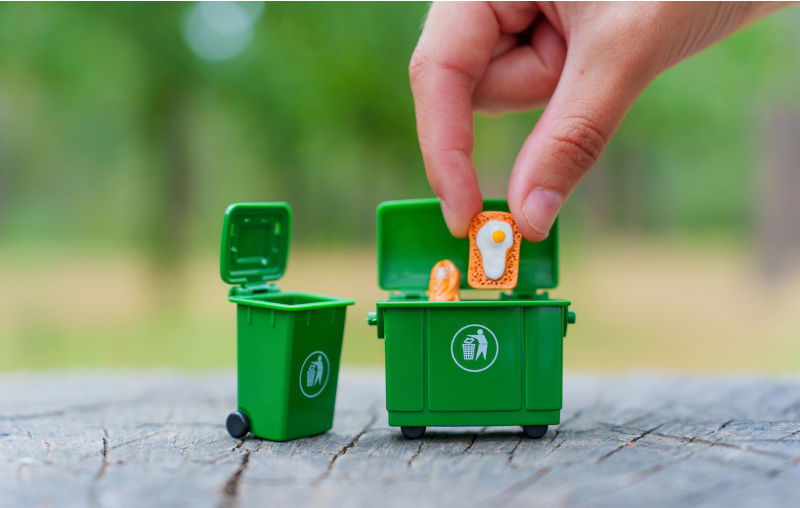Food waste collection services have dominated the discussion around landfill emissions recently. With a lot of things happening in the organic waste sector, I have recently mapped and met with many small-scale composters around Australia, to get an idea of the contribution that decentralised organic waste processing could make towards landfill reduction targets. The pattern emerging is that rural communities take to composting quite well, while the number of composting communities in Sydney and Melbourne is quite small. Brisbane, however, is quite surprising.
Most city councils and State agencies have lost interest in small-scale composting and are putting their full weight behind the kerbside collection services known as FOGO, though several councils have acknowledged significant challenges in moving food waste from the landfill-destined ‘red bin’ to a ‘green bin’ recycling system.
A National Food Waste Strategy to halve the volume of food in landfill has been put in place and several waste system changes have been made already. At the household level, most of us have begun separating food organics from other waste. For businesses (who pay directly for waste collection), numerous support mechanisms are on offer to reduce, separate and process organics. In terms of collection, waste pick-up services have been bolstered with measures such as weekly FOGO collection. The industrial waste processors have received support to install enhanced separation technology and processing capacity. And at the government level, councils have received funding to implement education campaigns (one council in Sydney employs people to look through FOGO bins at night and hang friendly printed reminders when they spot paper or other contaminants).
As a business, composting looks excellent on paper. Organic waste processors can usually collect ‘tipping fees’ to receive nitrogen- and carbon-rich waste, andsales revenue from selling compost to the farmers who are regularly exposed to price shocks in fertiliser supplies. But in Australia, things are complicated. Much of the organic waste received by processors is contaminated with , PFAS and asbestos-laden construction waste, making separation costly. The resulting compost doesn’t really cater to the needs of farmers who are still dependent on easy-to-use but high-emission chemical fertilisers. It’s a frustrating situation given that two thirds of Australia’s 373 million hectares of agricultural land is degraded, depleted and contaminated.
Of course kerbside organic waste collection can theoretically mitigate methane emissions from current landfill operations and produce the compost needed to improve soils. But FOGO programs also generate additional CO2 emissions by transporting organics from households to processing plants, and finally to farms, parks, and old mining sites. These public-private partnerships aren’t cheap for the taxpayer, especially when the mulch and compost produced doesn’t meet standards.
Why policy makers and planners have selected one mode of service coverage as their favourite is unclear. When we look at the transport sector, there’s a diverse and dynamic interplay between government steering, market preferences, technical innovation and entrepreneurial push, resulting in public transport services, private vehicles, active transport corridors, ride-sharing and everything in-between. Similarly with internet services, you have fibre, cable, DSL, 4G, 5G, satellite and others. In the energy sector, generation technologies include solar, thermal, wind and hydro, as well as various storage technologies such pumped hydro, hydrogen, thermal storage and a plethora of battery and electrochemical options. (We even have numerous power distribution systems including the central electricity grid, mini-grids, swarm generation and storage, and standalone household services.)
But when the National Food Waste Strategy came into implementation, we disproportionately invested public funds in centralised collection and processing modalities despite the massive opportunities to reduce production of organic waste or process it close to home. The initial messaging around reduction and home composting has visibly declined, partly due to saturation, it being difficult to convince a significant number of additional households to take up often ineffective composting. Processing food and garden waste effectively in a residential garden is actually much more complicated than what gardening shows make out. Efficient and enjoyable composting depends on particular feedstock combinations, moisture levels, aeration, and a minimum volume of material. Those in the know can compost a tonne in a month in a square metre of space, but for the others who just throw their food scraps into a compost bin, the process is slow, smelly, laborious and ineffective.
Many experts here (and in the US) are asking why there is such limited promotion of community composting despite the national obsession with gardening, personal carbon footprints, and outdoor socialising. But now we are looking to Brisbane, where the City Council has supported an extensive network of composting hubs and rallied locals to bring their food waste to their closest non-profit community provider. It’s the kind of approach to infrastructure and community integration you would usually look for in Scandinavia or the Netherlands. Council provided the hubs with financial and technical support for installation, and drove a campaign of visibility and learning, matched by strong community support.
In a stunning twist of plot, the City of Brisbane has just announced the suspension of the food waste trial, advising residents to refrain from discarding food in their green bins. It’s quite a contrast to the success stories communicated, perhaps prematurely, in other cities, and probably a shock for the QLD State government after promising $151 million to ‘GROW FOGO’. Brisbane’s experience with FOGO collection was plagued by low uptake and costly implementation, with little buy-in from the trial suburbs where many backyards are large enough for residents to do their own composting. On the processing side, capacity with the existing industrial organic processors is limited and expansion is difficult, especially after the contamination issues happening during the adaptation period.
Each council is implementing FOGO at their own pace, often with differing methodologies and rules. Much money has already been spent by councils with poor results in terms of contamination, costs, commitment from households and businesses, and public confusion. Unfortunately different industrial processors have different technologies and systems, meaning that residents in different areas have to follow different rules. There is no clear national message to help people understand what to do with FOGO.
With such varying success rates in kerbside collection, the connection between urban populations and their environment and food chains is key for ecological sustainability. Composters and gardeners around the country are looking for ways to attract a more informed public to bring food scraps to their systems. It’s an excellent measure for public awareness and environmental sensitisation. But more than this, community composting as a ‘prong’ of the national food waste strategy, should contribute a huge volume of the landfill diversion target, at a very low cost, with practically zero methane and CO2 emissions.

Ashley Wearne
Ashley has developed and managed a variety of clean development projects with a focus on sustainable, decentralised infrastructure that is deeply integrated in the local community. Outside Australia, he has worked for Germany and the EU’s international development programs in Timor Leste, Uganda, Mozambique, and Europe, partnering with farmers, local and national governments, energy regulators and ministries. Currently, Ashley focuses on urban ecology projects connecting local communities to sustainable, low-tech approaches to environmental management. This work involves the piloting of local technologies and operational strategies and the engagement with land managers both government and private.Ashley holds a MA degree in international economics from Monash University. He is a founding member of the Australian Local Community Composters Alliance. He is also the Site and Sustainability Manager for 9 acres of crown land, and runs his own research and pilots through his organisation Ecology and Community.
